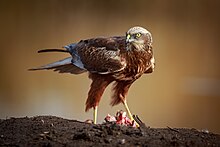Harrier (bird)
| Circus | |
|---|---|

| |
| Western marsh harrier | |
| Scientific classification | |
| Domain: | Eukaryota |
| Kingdom: | Animalia |
| Phylum: | Chordata |
| Class: | Aves |
| Order: | Accipitriformes |
| Family: | Accipitridae |
| Subfamily: | Circinae Bonaparte, 1838 |
| Genus: | Circus Lacépède, 1799 |
| Type species | |
| Falco aeruginosus Linnaeus, 1758
| |
| Species | |
A harrier is any of the several species of
Taxonomy

The
Ring-tails
Ring-tail is an informal term used by

Species
The genus contains 16 species:[8]
- Montagu's harrier, Circus pygargus – Eurasia, winters in Africa and India
- Hen harrier, Circus cyaneus – Eurasia
- Northern harrier, Circus hudsonius – North America[9]
- Western marsh harrier, Circus aeruginosus – Europe, western Asia; winter range includes Africa and India.
- Eastern marsh harrier, Circus spilonotus – Asia (migratory)
- African marsh harrier, Circus ranivorus – southern and central Africa
- Swamp harrier, Circus approximans – New Zealand, Australia, Pacific islands
- Papuan harrier, Circus spilothorax – New Guinea (formerly treated as a subspecies of C. spilonotus, then C. approximans, but now considered distinct)
- Malagasy harrier, Circus macrosceles (formerly in C. maillardi) – Indian Ocean (Madagascar and the Comoro Islands)
- Réunion harrier, Circus maillardi – (Indian Ocean) Réunion Island
- Long-winged harrier, Circus buffoni – South America
- Spotted harrier, Circus assimilis – Australia, Indonesia
- Black harrier, Circus maurus – southern Africa
- Cinereous harrier, Circus cinereus – South America
- Pallid harrier, Circus macrourus – migratory: eastern Europe, Asia, Africa (winter)
- Pied harrier, Circus melanoleucos – Asia
Fossils
- † prehistoric)
- † prehistoric)
The subfamily Circinae has traditionally included the genera
References
- PMID 25701771.
- ^ Lacépède, Bernard Germain de (1799). "Tableau des sous-classes, divisions, sous-division, ordres et genres des oiseux". Discours d'ouverture et de clôture du cours d'histoire naturelle (in French). Paris: Plassan. p. 4. Page numbering starts at one for each of the three sections.
- ^ Mayr, Ernst; Cottrell, G. William, eds. (1979). Check-list of Birds of the World. Volume 1 (2nd ed.). Cambridge, Massachusetts: Museum of Comparative Zoology. p. 316.
- ^ Lesson, René P. (1828). Manuel d'ornithologie, ou Description des genres et des principales espèces d'oiseaux (in French). Vol. 1. Paris: Roret. p. 105.
- ISBN 978-1-4081-2501-4.
- ^ Hogg, John (1845). "A catalogue of birds observed in South-eastern Durham and in North-western Cleveland". The Zoologist. 3: 1049–1063.
- ^ "Harriers in India: A Field Guide" (PDF). wwt.org.uk. Wetland Link International. Archived (PDF) from the original on 2022-10-09. Retrieved 27 January 2021.
- Rasmussen, Pamela, eds. (August 2022). "Hoatzin, New World vultures, Secretarybird, raptors". IOC World Bird List Version 12.2. International Ornithologists' Union. Retrieved 6 December 2022.
- .
- .
- .
External links
- Harrier videos on the Internet Bird Collection
- Harrier videos on the Internet Bird Collection
- Newton, Alfred (1911). . Encyclopædia Britannica. Vol. 13 (11th ed.). p. 17.
